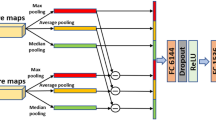Abstract
Convolutional neural networks (CNN) have been shown to deliver outstanding performance for image quality assessment (IQA). Most CNN models are trained using small image patches with a fixed resolution of 32 × 32. However, more information of image content and human visual system should be taken into account. This paper proposes a post segmentation based CNN model for no-reference quality assessment without any pre-processing. The network consists of five convolutional layers with max pooling, one special fully connected layer feature-segmentation and one output layer. This paper adopts the feature-segmentation strategy to assure enough training data. We modify the structure of fully connected layer and regard every feature vector of the last pooling maps as an independent sample to train our proposed model. In this way, the raw images can be fed into the input and do not need to be split into patches, to avoid any hand-crafted features. Moreover, the size of the input images is not fixed, and the size of the extracted feature vector is invariant. Experiments on LIVE, CSIQ and TID2008 databases demonstrate that our approach has high consistency with the subjective evaluation scores. The experimental results show that the proposed network outperforms state-of-the-art no-reference IQA algorithms and is comparable to some full-reference IQA algorithms.



Similar content being viewed by others
References
Bosse S, Maniry D, Mller K-R, et al. (2016) Deep neural networks for no-reference and full-reference image quality assessment. IEEE Trans Image Process 27 (1):206–219
Glorot X, Bengio Y (2010) Understanding the difficulty of training deep feedforward neural networks. In: Proceedings of the thirteenth international conference on artificial intelligence and statistics. Sardinia, pp 249–256
Group VQE (2000) Final report from the video quality experts group on the validation of objective models of video quality assessment, Phase II (FR TV2), VQEG meeting, Ottawa, Canada
Gu J, Meng G, Redi JA, et al. (2018) Blind image quality assessment via vector regression and object oriented pooling. IEEE Trans Multimed 20(5):1140–1153
Hao S, Pan D, Guo Y, et al. (2016) Image detail enhancement with spatially guided filters. Signal Process 120:789–796
He K, Zhang X, Ren S, et al. (2016) Deep residual learning for image recognition. In: Proceedings of the IEEE conference on computer vision and pattern recognition. Las Vegas, Nevada, pp 770–778
Holzinger A (2018) From machine learning to explainable AI. 2018 World Symposium on Digital Intelligence for Systems and Machines (DISA)
Holzinger A, Langs G, Denk H, et al. (2019) Causability and explainability of AI in medicine. Wiley Interdisciplinary Reviews: Data Mining and Knowledge Discovery
Hou W, Gao X, Tao D, et al. (2015) Blind image quality assessment via deep learning. IEEE Trans Neural Netw Learning Sys 26(6):1275–1286
Ioffe S, Szegedy C (2015) Batch normalization: accelerating deep network training by reducing internal covariate shift
Jin X, Wu L, Li X, et al. (2016) ILGNet: inception modules with connected local and global features for efficient image aesthetic quality classification using domain adaptation. IET Computer Vision: 1–7
Kang L, Ye P, Li Y, et al. (2014) Convolutional neural networks for no-reference image quality assessment. In: Proceedings of the IEEE conference on computer vision and pattern recognition, pp 1733–1740
Kim J, Lee S (2017) Fully deep blind image quality predictor. IEEE J Select Topics Signal Process 11(1):206–220
Kingma DP, Ba J (2014) Adam: a method for stochastic optimization. In: International Conference on Learning Representations. Banff, Canada
Krizhevsky A, Sutskever I, Hinton GE (2012) Imagenet classification with deep convolutional neural networks. In: Advances in neural information processing systems, pp 1097–1105
Larson EC, Chandler DM (2010) Most apparent distortion: full-reference image quality assessment and the role of strategy. J Electron Imaging 19(1):011006
LeCun YA, Bottou L, Orr GB, et al. (2012) Efficient BackProp, in Neural Networks: Tricks of the Trade (Lecture Notes in Computer Science) 7700: 9–48
Liu X, Joost VDW, Bagdanov AD (2017) RankIQA: Learning from Rankings for No-reference Image Quality Assessment
Ma K, Liu W, Zhang K, et al. (2018) End-to-end blind image quality assessment using deep neural networks[J]. IEEE Trans Image Process 27(3):1202–1213
Mittal A, Moorthy AK, Bovik AC (2012) No-reference image quality assessment in the spatial domain. IEEE Trans Image Process 21(12):4695–4708
Moorthy AK, Bovik AC (2010) A two-step framework for constructing blind image quality indices. IEEE Signal Process Lett 17(5):513–516
Ponomarenko N, Lukin V, Zelensky A, et al. (2009) TID2008-a database for evaluation of full-reference visual quality assessment metrics. Advances of Modern Radioelectronics 10(4):30–45
Saad MA, Bovik AC, Charrier C (2012) Blind image quality assessment: a natural scene statistics approach in the DCT domain. IEEE Trans Image Process 21 (8):3339–3352
Sheikh HR, Sabir MF, Bovik AC (2006) A statistical evaluation of recent full reference image quality assessment algorithms. IEEE Trans on Image Process 15 (11):3440–3451
Shijie H, Yanrong G, Zhongliang W (2019) Lightness-aware contrast enhancement for images with different illumination conditions. Multimed Tools Appl 78:3817–3830
Wu J, Zhang M, Shi G, et al. (2018) No-reference image quality assessment with orientation selectivity mechanism[C]// IEEE International Conference on Image Processing. IEEE
Xue W, Mou X, Zhang L, et al. (2014) Blind image quality assessment using joint statistics of gradient magnitude and Laplacian features. IEEE Trans Image Process 23(11):4850–4862
Zhang L, Zhang L, Mou X, et al. (2011) FSIM: a feature similarity index for image quality assessment. IEEE Trans Image Process 20(8):2378–2386
Acknowledgements
This research is partially supported by the National Natural Science Foundation of China (No. 61520106002).
Author information
Authors and Affiliations
Corresponding author
Additional information
Publisher’s note
Springer Nature remains neutral with regard to jurisdictional claims in published maps and institutional affiliations.
Rights and permissions
About this article
Cite this article
Shen, L., Hang, N. & Hou, C. Feature-segmentation strategy based convolutional neural network for no-reference image quality assessment. Multimed Tools Appl 79, 11891–11904 (2020). https://doi.org/10.1007/s11042-019-08298-2
Received:
Revised:
Accepted:
Published:
Issue Date:
DOI: https://doi.org/10.1007/s11042-019-08298-2




